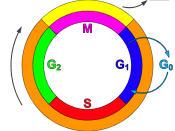Cellular Reproduction is the process by which all living things produce new organisms similar or identical to themselves. This has to happen because if a species were not able to reproduce, that species would quickly become extinct. Reproduction consists of a basic pattern: the conversion by a parent organism of raw materials into offspring or cells that will later develop into offspring. The reproductive process, whether asexual or sexual always involves an exchange in hereditary material from the parents so that the new organism may also be able to reproduce. Reproductive processes can be categorized into either asexual reproduction or sexual reproduction.
Asexual reproduction is any form of reproduction that does not require the union of male and female reproductive material (sperm or egg). Most single celled organisms reproduce by the asexual process known as fission, which is commonly called mitosis. Fission is the splitting of a nucleus into two roughly equal parts accompanied by the release of a pretty large amount of energy.
Interphase, the first phase of the cell cycle and also the phase before mitosis, starts as soon as the cell is born. Interphase is broken up into three phases, G1, S, and G2. During the G1 phase, the cell increases in mass except for the chromosomes, which stay the same. Protein synthesis is also occurring during this phase. If a cell doesn't divide further, it remains in the G1 phase. Next is the S phase, in which the mass of the cell continues to increase, and DNA is duplicated, and then the chromosomes divide. During the G2 phase of Interphase, the cell becomes double its mass at birth, the chromosomes begin to shorten and coil, and the centrioles appear, the cell is now ready to enter into mitosis.
In the first phase of mitosis, prophase, the...



Cell Reproduction
i think this is a pretty decent essay, but ur missing alot. u should add a little about the the evolutionary part of reproduction. when i say this i dont mean evolution as a entire belief like on a large scale, im just refering to the small types of evolution, like survival of the fittest. one example of this would be the changing beak sizes on the gallapagos islands
2 out of 2 people found this comment useful.